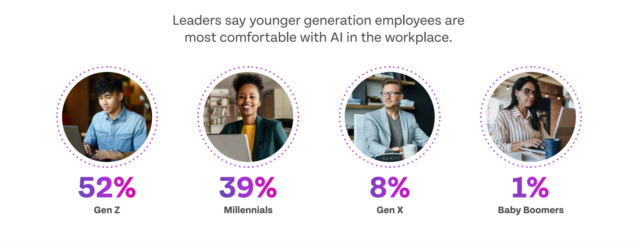Addressing the demographic divide in AI comfort levels

Today, 37 percent of respondents said their companies were fully prepared to implement AI, but looking out on the horizon, a large majority (86 percent) of respondents said that their AI initiatives would be ready by 2027.
In a recent Riverbed survey of 1,200 business leaders across the globe, 6 in 10 organizations (59 percent) feel positive about their AI initiatives, while only 4 percent are worried. But all is not rosy. Senior business leaders believe there is a generational gap in the comfort level of using AI. When asked who they thought was MOST comfortable using AI, they said Gen Z (52 percent), followed by Millennials (39 percent), Gen X (8 percent) and Baby Boomers (1 percent).
Clearly, business leaders believe that the younger generations have a higher level of comfort with AI utilization. The higher comfort level makes sense based on real-world experiences. Gen Z has grown up accustomed to a wealth of digital possibilities, and Millennials have seen their lives changed by digital technologies. Many Millennials are now transforming the workplace as managers and leaders. In contrast, those with more experience in the workplace can feel more uncertainty about new ways of working.
As Gen X and baby boomers are still often the decision-makers within organizations, addressing this generational gap is critical for companies as they hope to move from the promise of AI to implementing the AI that transforms businesses and delivers bottom-line results.

Attracting and Retaining Younger Leaders
There is a demographic shift in the workforce. Today, roughly 50 percent of all employees are either Gen Z and Millennials. In 2030, as boomers and Gen X leave the workforce, Gen Z and Millennials will make up 70 percent of the workforce.
This approaching demographic shift has consequences right now. According to Riverbed’s 2023 Global Digital Employee Experience (DEX) survey, a majority of business leaders (63 percent) say failing to meet the digital experience demands of younger generations would be disruptive to their companies, and 68 percent believe Millennials & Gen Z employees would consider leaving the company.
There is good news in the 2024 survey: 94 percent of respondents agreed that AI will help them deliver a better digital experience for end users. So, companies can and should promote their use of AI to attract and retain young talent.
However, for companies that want to fully leverage their investments in AI, it is not enough to focus solely on using AI to deliver better DEX for younger workers. To make AI transformational, organizations must also improve their more senior-level employees’ comfort level when using AI.
High Performing Companies Invest in Training
High-performing companies are more likely to report that AI is being leveraged to its full capabilities in their organization to improve the user’s digital experience compared to low performers (67 percent vs. 45 percent).
- In the survey, high performers are defined as those with an average change in revenue of 10.5 percent or more, and low performers are those with an average change in revenue over three years of -12 percent up to 0.5 percent.
One key reason for high performers’ successful implementations of AI is they are more likely to provide extensive training on how to use AI responsibly versus low performers (63 percent vs. 41 percent). They’re also more likely to have implemented AI extremely successfully in their IT services (49 percent vs. 30 percent low performers). High performers have found that advanced training decreases the amount of resistance to change and time Gen. X and Baby Boomers need to become proficient in leveraging AI. The importance of training cannot be overstated. Training on AI utilization helps all employees more effectively use AI to transform the business. Currently, most organizations are using AI in IT to drive operational efficiencies. In as few as three years’ time, most companies expect AI to drive business productivity and improve profits.
Although AI is currently sliding through a period of disillusionment after being overhyped, within three years high-performing companies’ ability to utilize AI to drive bottom-line results will increase their lead over performers. Investing in training now is critical for the long-term success of AI implementations.
Follow the Leaders
High-performing organizations prioritize AI, and in the survey, AI is more of a strategic priority across their organization than it is for low performers (74 percent vs. 56 percent). High performers are not overconfident in their approach to AI adoption but invest strategically in the technology and make rapid progress. They tend to use AI to focus on DEX and provide extensive employee training on AI. As organizations around the world strive to achieve their full AI-driven potential, they have to remove obstacles that might hamper the swift deployment and effectiveness of their AI initiatives.
While senior leadership, 94 percent, across almost every organization acknowledges that AI is a strategic priority for their organization, they should also understand that there are demographic differences between the acceptance of AI that could hinder the success of a company's AI deployments. For AI to achieve optimal efficiencies in IT operations and improve overall employee productivity, senior leadership should follow the lead of high-performing companies and invest in strategic training programs.
Image credit: denisismagilov/depositphotos.com
Fernando Castanheira is CIO, Riverbed.
